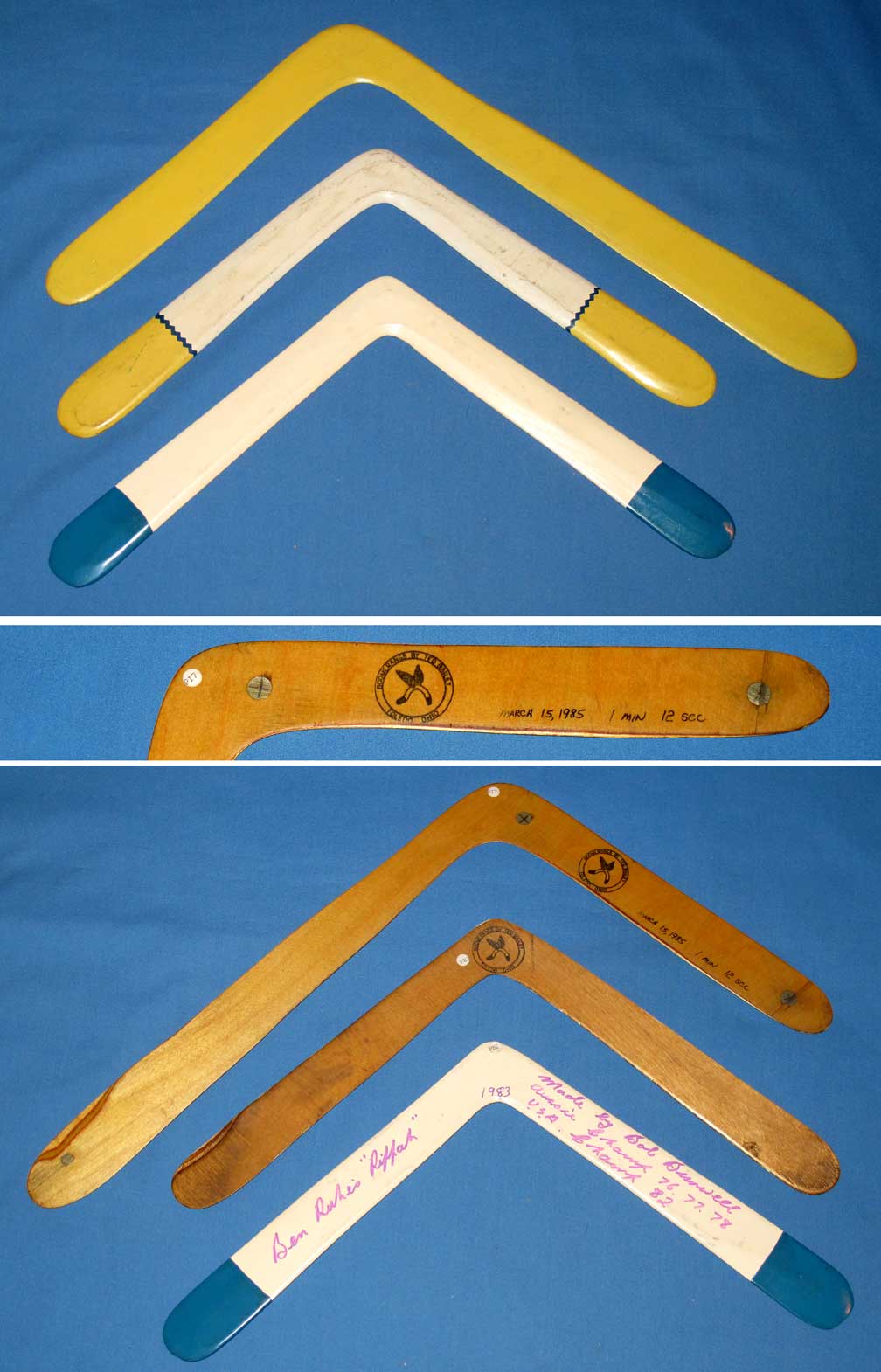Item PI7
This Item was Sold on 6 January
2025 for $220
Other collectable boomerangs for sale can be found on the
Collectable Boomerangs link.
Historical Pricing information for this item and similar collectable boomerangs can be found on the Boomerang Pricing Guide
|
I developed my version of the Maximum Time Aloft (MTA) boomerang during the winter of 1984/1985. I read about this technology in the BBS Journal and inspecting plans sent by Ben Ruhe. Ben's nephew, Barnaby Ruhe, had brought tracings of David Schummy's MTA designs when he returned home from Europe. Ben sent the plans to me but I did nothing with MTA until I went to the 1984 Challenge Match in Delaware, Ohio. I saw Peter Ruhf throwing his large MTA and getting flight times of 30+ seconds. Peter did not want any one to see what he was using, so he hid his MTA in a large sock in between throws. I saw enough of this hockey stick shape to start developing my own MTA design and this effort was completed in the Spring of 1985. During the Fall and Winter months of 1984/1985, I made a few MTAs that did not work well. I had flights of 20-25 seconds and they did not have stable flights. I worked at Teledyne CAE, an Aerospace Company located in Toledo, Ohio. I could order anything I wanted through the company's library, so I ordered several technical papers about Maple Seed Samaras as well as several publications on low Reynolds Number airfoils and rotation airfoils. As I learned the essentials of flight tuning, I decided to test most boomerangs in my collection to find the best spin rate and stable flight. I took almost 100 boomerangs down to the field at threw every one. The best flyer in my collection was a V100 Traditional made by Bob Burwell in 1982. This model was called the Rippah and I had purchased it from Ben Ruhe. It is the white boomerang with blue tips in the photo (PB2). The first thing I did was to make a copy and try to match the Burwell airfoils as much as possible. This is the white boomerang with yellow tips in the photo below (PR3). The next step was to put a tail (longer lift arm) on PR3 and add the tuning features that I learned from the Aerospace documents. The final result was the large MTA at the top of the photo (PI7). I added lead weights to move the center of mass to the optimal location and then I added dihedral and angle of attack to both blades and put a coat of paint on the upper surface. My first flight with this MTA design was on 15 March 1985. After a couple of throws to adjust the tuning, I had a flight of 72 seconds. This was my Kitty Hawk moment. I knew that I could easily repeat the long flight times with this MTA. I did not need a lucky accidental tune or a magical gust of wind to break the 1 minute barrier. This MTA is the predecessor of the Maxi and Midi MTAs that followed shortly thereafter. Using an Engineering tool, Buckingham Pi, used for dimensional scaling, the much smaller Mini MTA was developed only 5 weeks later. I had several long flights on that first day and then I retired this MTA and used it as a starting place for the development of future designs. I have not thrown this MTA since 1985 and it is in mint condition. PI7 - Right Handed ; Tip-to-tip Span = 50 cm ; Weight = 54 gm PR3 - Right Handed ; Tip-to-tip Span = 39 cm ; Weight = 48 gm PB2 - Right Handed ; Tip-to-tip Span = 39 cm ; Weight = 54 gm
Ted Bailey is a retired Aerospace Engineer who has been making and throwing boomerangs since the early 1970s. The first boomerangs he marketed were multibladers sold on the C.S.U. Sacramento campus in the early 1970s. In the late 1970s, Ted sold traditional boomerangs at the West Palm Beach Mall. In the early 1980s, Ted moved to Ohio and started throwing in Ohio tournaments He developed a line of miniature boomerangs that performed well in competition. In the 1980s, new products included lap joint boomerangs made out of exotic woods and high performance competition boomerangs, especially Fast Catch and MTA. Ted was active in the USBA and served as Secretary, President and as a board member in the 1980s. He was the editor of the USBA newsletter, Many Happy Returns, for two decades and also produced two independent publications: Boomerang Journal and Boomerang News. Ted taught Flying Toy classes in several schools located in Ann Arbor, Michigan. Currently, Ted is retired and involved in internet marketing of boomerang products. |

How to Order | Back to: Boomerang Catalog | Collectable Boomerangs | Boomerang Pricing Guide | contact: Ted Bailey